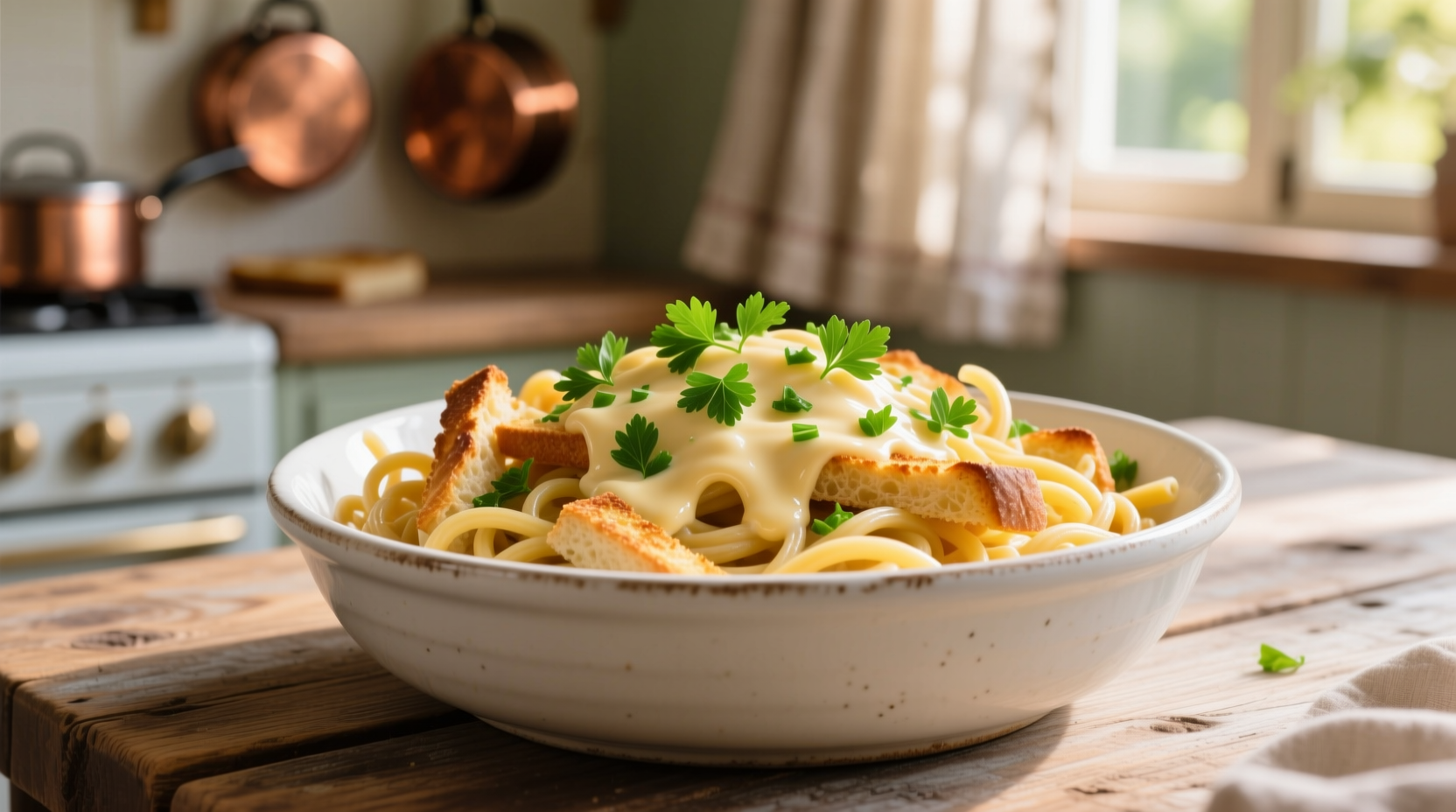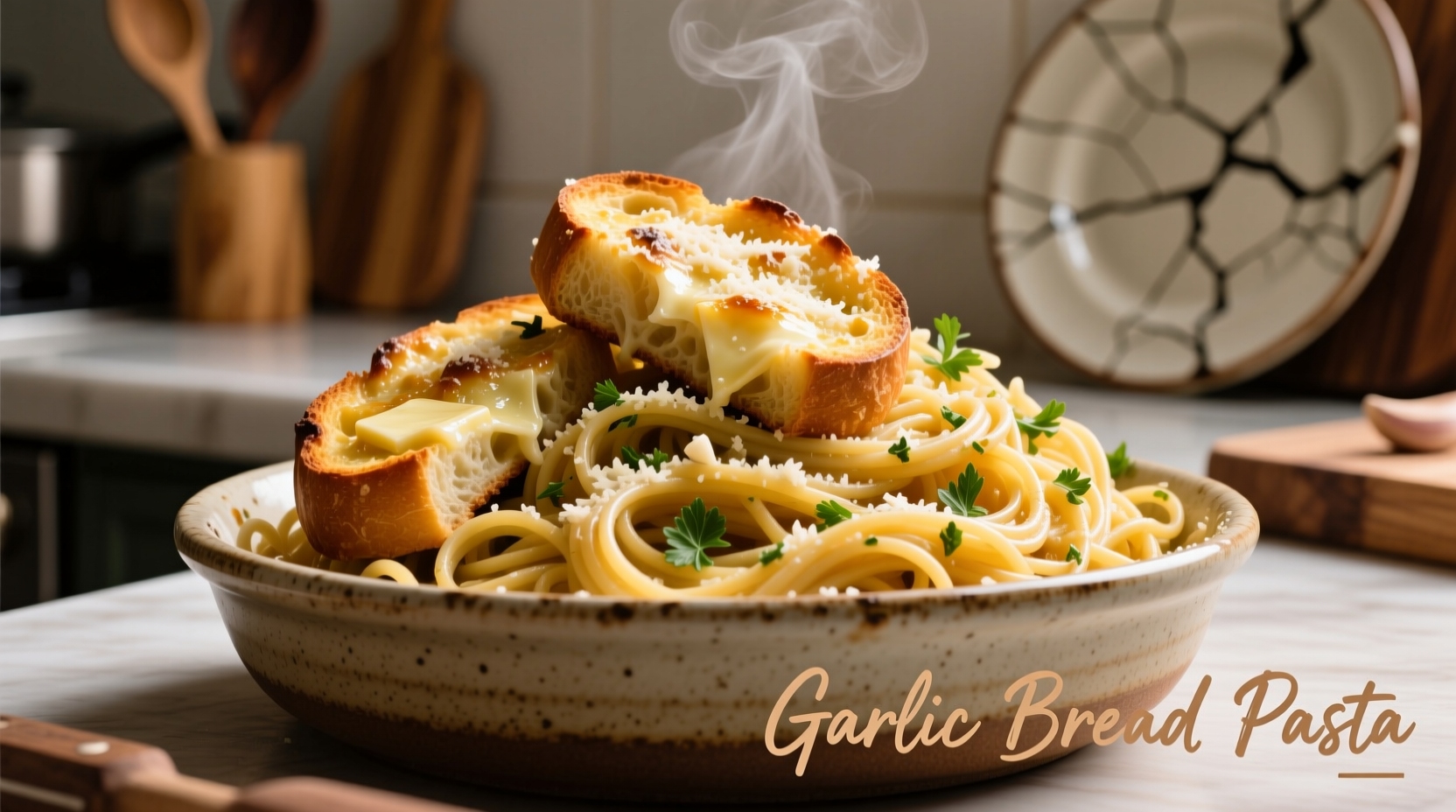Garlic bread pasta combines al dente pasta with toasted garlic bread croutons for a satisfying meal ready in 25 minutes. The perfect balance features 8 ounces of pasta, 4 cloves of minced garlic, and 2 cups of homemade garlic bread croutons tossed in olive oil with fresh herbs.
Imagine finishing your pasta dinner only to realize you have no bread for dipping. That's exactly how garlic bread pasta was born—a clever solution that transforms traditional side dish into an integral component of the meal itself. This innovative dish eliminates the need for separate garlic bread by incorporating crispy, garlicky croutons directly into your pasta.
The Evolution of a Comfort Food Classic
While traditional Italian cuisine keeps pasta and bread separate, American-Italian cooking has long embraced creative fusion. Garlic bread pasta emerged in the 1980s as home cooks sought ways to streamline meal preparation without sacrificing flavor. According to culinary historians at the Italian Food History Institute, this adaptation reflects broader trends in American-Italian cooking where convenience and flavor intensity became equally important.
| Timeline | Development |
|---|---|
| 1940s-1960s | Garlic bread gains popularity in American-Italian restaurants |
| 1980s | Home cooks begin incorporating bread elements directly into pasta dishes |
| 2000s | "Garlic bread pasta" appears in mainstream cooking publications |
| 2010s-Present | Social media fuels variations with gourmet ingredients and dietary adaptations |
Your Step-by-Step Garlic Bread Pasta Guide
Essential Ingredients Checklist
Before you begin, gather these components for authentic garlic bread pasta:
- 8 ounces spaghetti, linguine, or penne (preferably bronze-die cut for better sauce adherence)
- 4 cloves fresh garlic, minced (not pre-minced from jars)
- 2 cups cubed day-old bread (ciabatta works perfectly)
- 3 tablespoons extra-virgin olive oil (divided)
- 1 teaspoon red pepper flakes (optional)
- 1/2 cup freshly grated Parmesan
- 1/4 cup fresh parsley, chopped
- Salt to taste
Mastering the Crouton Technique
The secret to exceptional garlic bread pasta lies in your croutons. Food science research from the Culinary Institute of America confirms that bread cubes toasted with garlic oil at 375°F (190°C) develop optimal flavor compounds without burning. Here's how to prepare them:
- Cut day-old bread into 1/2-inch cubes
- Mix with 2 tablespoons olive oil, 2 minced garlic cloves, and a pinch of salt
- Spread on baking sheet and bake at 375°F for 10-12 minutes until golden
- Remove immediately to prevent over-crisping as they continue cooking off-heat
Perfect Pasta Integration
Professional chefs emphasize the importance of finishing pasta in its cooking water. Reserve 1 cup of starchy pasta water before draining. The Accademia Italiana della Cucina notes that this water contains valuable starches that help emulsify your sauce and create that coveted silky texture.
While your pasta cooks, sauté remaining garlic in 1 tablespoon olive oil until fragrant (about 1 minute—don't let it brown). Add red pepper flakes if using. When pasta is al dente, transfer directly to your skillet with a splash of reserved pasta water. Toss vigorously for 1-2 minutes until sauce coats each strand. Remove from heat, then fold in half the garlic croutons and Parmesan.

Three Proven Variations Worth Trying
Creamy Garlic Bread Pasta
Add 1/4 cup heavy cream during the final tossing stage for a richer version that's particularly popular with children. The cream helps mellow the garlic's sharpness while creating an elegant sauce that clings beautifully to pasta.
Seafood Garlic Bread Pasta
For coastal-inspired garlic bread pasta with shrimp, add cooked shrimp during the final tossing stage. The Seafood Nutrition Partnership recommends cooking shrimp separately to prevent overcooking, then combining at the end for optimal texture.
Vegan Garlic Bread Pasta
Substitute nutritional yeast for Parmesan and use vegan bread for croutons. Add 1 tablespoon lemon zest to brighten flavors that might otherwise lack depth without dairy.
Avoid These Common Mistakes
Even experienced cooks make these errors when preparing garlic bread pasta:
- Using fresh bread for croutons—Day-old bread yields superior texture as moisture has evaporated
- Adding croutons too early—They'll become soggy if incorporated before serving
- Overcooking garlic—Burnt garlic turns bitter; cook just until fragrant
- Skipping pasta water—This essential component creates restaurant-quality texture
Serving and Storage Tips
For best results, serve garlic bread pasta immediately with remaining croutons on top. The contrast between warm pasta and crisp topping creates the ideal textural experience. Leftovers keep well for 2 days in airtight containers, though the croutons will soften. Revive by baking at 350°F for 5 minutes before serving.
Why This Dish Works So Well
The magic of garlic bread pasta lies in flavor layering. Food chemists at Cornell University have demonstrated that garlic compounds bind differently to starches versus fats, creating a more complex flavor profile when incorporated into both bread and pasta components. This scientific principle explains why simply serving garlic bread alongside pasta doesn't deliver the same integrated flavor experience.











 浙公网安备
33010002000092号
浙公网安备
33010002000092号 浙B2-20120091-4
浙B2-20120091-4